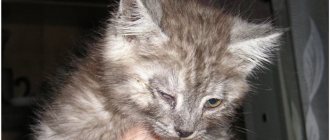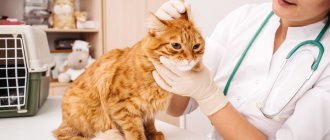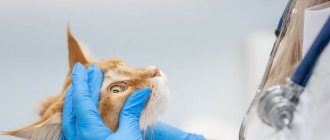In this article, we are going to explain how to heal a dog's eye sore by distinguishing whether it occurs around or inside the eye. The wound on one eye, due to its location, is different from wounds on other parts of the body, so it cannot be treated in the same way. Additionally, most of these wounds will require examination by a veterinarian as we may be dealing with damage to the eye that is causing serious injury.
If your dog has injuries around or inside the eye and you don't know what to do, read on and use the first aid we share.
Types of eye damage in dogs
It also happens that an eye injury in a dog may go unnoticed, although it can lead to serious consequences.
In the worst case scenario, the pet may completely lose its organ of vision. Damage and its causes are varied, which will be discussed below.
Mechanical injury
The cause of a mechanical injury may be a skirmish with another dog, an unsuccessful encounter with a cat, or the pet may simply stumble upon a branch or sharp object. The severity of the damage also varies.
The most dangerous situation is an injury to a dog’s eye with a sharp object, when the cornea is damaged and various bacteria and microbes penetrate into the wound and, as a result of their vital activity, can provoke complete loss of vision.
It is worth paying attention if the dog begins to squint or has completely closed its eye, purulent or bloody discharge occurs from the corners, and the pet does not allow itself to be examined, prevents the opening of the eyelid, and is clearly in pain - it is necessary to promptly show the animal to a veterinarian-ophthalmologist. There is a chance to prevent vision loss, but surgery may be required.
With traumatic injuries from blunt objects, the danger is lower, but nevertheless high.
Damage may be internal and invisible. Blunt trauma to a dog's eye can cause retinal rupture or detachment, internal hemorrhage, and swelling of the optic nerve. So if there is a suspicion of injury, it is better to show the animal to the doctor, it will be easier to avoid complications.
Redness of the eyes
The causes of redness vary. Perhaps a foreign object has gotten under the third eyelid, scratching the cornea and causing irritation. The foreign body should be removed and the animal should be shown to a doctor to ensure that it has been completely removed and there is no risk of developing other problems.
It is especially important to take a closer look at the nature of the redness, if it looks more like a pinkish film - there is a risk that the pet has developed the so-called pannus - clouding of the surface layer of the cornea. If you do not see a doctor in time, there is a risk of vision loss.
By the way, another cause of redness and irritation of the organs of vision may be an inversion of the lower eyelid, which is not an injury, but significantly interferes with the comfortable existence of the pet. The eyelashes of the rolled eyelid scratch the cornea, causing irritation and increased tearing. The issue is resolved surgically.
It could also be caused by high blood pressure or an allergic reaction.
Purulent discharge
If first clear and then purulent discharge is detected, accompanied by swelling of the eyelid, this is a sign of conjunctivitis, inflammation of the mucous membrane of the eyelid. In the case of thick, cloudy discharge, the cause is most likely an infection, although the development of the disease may be associated with injury. For example, with the entry of a foreign body.
It happens that conjunctivitis develops as a concomitant disease as a result of a general decrease in immunity. Despite the fact that conjunctivitis is not so difficult to cure, the dog should be shown to a doctor in order not only to make a correct diagnosis, but also to find out and eliminate the cause of the disease.
Eyeball prolapse
In some cases, an eye injury in a dog can provoke a very unpleasant consequence - apple loss. A similar situation often happens with representatives of brachycephalic breeds (Pekingese, bulldogs, pugs, etc.) A feature of representatives of such breeds is a flattened muzzle and bulging eyes.
If such a situation occurs, the main thing is not to panic. The best option is to put the apple back in place as carefully as possible and, to save your pet’s vision, immediately take him to an ophthalmologist or surgeon. Apply a damp gauze bandage and do not allow it to dry until the animal reaches the doctor.
Increase
Sometimes it happens that one eye becomes enlarged, and occasionally both. This is also a reason to sound the alarm, grab the animal in your arms and rush to the veterinarian.
The cause of this phenomenon is highly likely to be an increase in intracranial or intraocular pressure. The latter happens due to inflammatory processes, lens dislocation, and even kidney failure.
In this situation, the doctor will measure the pressure, examine the fundus of the eye, and most likely conduct a blood test. Based on the test results, the cause of the increase in pressure will be determined.
Swelling
If a red swelling appears, do not panic; in most cases it will not be a tumor or adenoma. Most likely, this is an inversion of the lacrimal gland or lower eyelid that needs to be realigned.
Otherwise, there is a risk of developing “dry eye syndrome,” which will then have to be treated for the rest of your pet’s life. There are also very unpleasant consequences that can develop: corneal ulcer, keratitis or conjunctivitis.
First aid
If a dog has an eye injury, treatment should be carried out by a veterinarian, and it is better to do this as soon as possible. But first aid must be provided until the pet is delivered to the clinic.
It is necessary to prevent the animal from scratching the damaged organ on the way to the veterinary clinic. If possible, use a specialized collar or simply hold the dog by the paws when trying to scratch.
To reduce the pet's pain, local anesthesia by instilling a 2% novocaine solution is recommended. It is advisable to have such a medicine with you, especially when going hunting in the first aid kit.
If a dog does not allow its eyes to be opened, you should not force it open, even to administer anesthesia. Otherwise, you can only injure him more; such a task should be left to a specialist.
As an exception, if it is not possible to immediately show your pet to a doctor, you need to instill eye drops for the dog, these are antibiotics (Tsiprovet, Gentamicin, Torbex). The dose must be calculated according to the instructions for the drugs based on the body weight and size of the dog.
Symptoms
Mechanical damage to the visual organ is characterized by the sudden onset of symptoms. At the same time, the pet’s eyelids swell, the eye itself turns red, the animal becomes restless and constantly tries to wipe the damaged area with its paws. Sometimes the owner may notice blood stains in the injured area. The easiest way to detect damage is if a foreign object, such as a blade of grass or a small midge, gets into your pet's eye.
The severity of the injury can be checked using an ordinary flashlight. It is enough to direct a beam of light into the damaged eye and see if the pupil has dilated. If there is no reaction, then the injury is very serious, and the animal must be urgently taken to a doctor for examination. With such signs, when the eyeball becomes dark or protrudes beyond the orbit, we can say with confidence that pathogenic microflora has entered the tissue. An animal with such symptoms requires prompt and qualified treatment.
Corneal injury is a very serious pathology that can lead to blindness in a dog. The main signs of such damage are that the dog constantly squints his eyes. He may experience uncontrollable spasms of the eyelids and photophobia. Under no circumstances should you let your pet scratch the damaged area. Against the background of injury, keratitis can develop, an inflammation that leads to clouding of the cornea.
Treatment
Any treatment should be carried out only after examination by a veterinarian, examination and a clear diagnosis. In particular, if a dog has an inflamed eye, the doctor will tell you how to treat it; you should not self-medicate.
Examination by a specialist
The first thing to do is, if possible, carefully deliver the animal to a clinic where you can entrust your dog.
Ideally, show the dog to an ophthalmologist. However, such specialists of a narrow profile do not work in all clinics, so in some situations you can turn to surgeons or general practitioners.
The examination may include full general tests to detect infections and a mandatory examination. You may need to measure intraocular pressure and even prescribe surgery.
It is important to identify the problem based on the results of tests and examination and make the correct diagnosis. The owner must strictly follow all recommendations received.
Eye drops
Sometimes it is enough to instill eye drops in case of an eye injury in a pet; this also applies to inflammatory diseases such as conjunctivitis.
Owners can get confused because they don’t always know how to put drops in their dog’s eyes. You need to follow some simple recommendations.
First, you need to wash your hands thoroughly to avoid infection, which will aggravate the inflammation process. Then carefully clean off pus and secretions, and also rinse the area around the eyes.
As a rule, dogs do not like such procedures and can behave very nervously, but under no circumstances should you scold them or raise your voice. Calming intonations, some encouragement, and affection will help you cope with the animal and make the procedure as painless and comfortable as possible from a psychological point of view. Although large dogs should wear a muzzle to avoid injury to the owner.
Drops for eye injuries are instilled in strict accordance with the prescribed dosage and doctor's prescription.
Prevention
There is no one hundred percent guarantee that a pet will never be injured, but loving owners are responsible for it and must make efforts to minimize such risks.
It is important to choose the right places for walking with your animal, to avoid abandoned construction sites and overgrown paths in park areas.
Hunters need to choose the right breed of dog, since much depends on what animal is being hunted and what is required from the dog.
During play, you should follow safety precautions when working with an animal and not expose it to unnecessary risk of injury.
It is also worth excluding contacts with unfamiliar and especially stray dogs as much as possible. It is necessary to limit possible meetings with felines (unless this is a dog’s best friend). Otherwise, your pet may suffer from sharp claws.
Causes
Damage to the eye apparatus is a fairly common reason why dog owners seek help from a specialist. In most cases, injury to the organ of vision occurs due to the following factors:
- The pet loves to chase cats. This “centuries-old enmity” often ends very badly. Not only can a dog injure his eyes during the chase, for example, by catching on a branch or twig, but also the cat’s claws are a dangerous weapon that can deprive the unlucky “hunter” of sight.
- During various festivals, especially in winter, animals whose eyes have been injured by firecrackers or fireworks often come to see a doctor. For many of them, such injuries result in complete blindness.
- Hunting breed dogs are at constant risk. The very nature of their activity is often full of factors damaging the ocular apparatus: dry stubble, reeds, spruce branches, sand and twigs. The eyelids take on an avalanche of damage, which can cause them to swell and, over time, become inflamed.
- Young and inexperienced pets can damage their eyes when playing too long with another animal or owner.
- For service and fighting dogs, the chance of losing an eye is especially high, this is due to the functions that the owner assigns to them.











